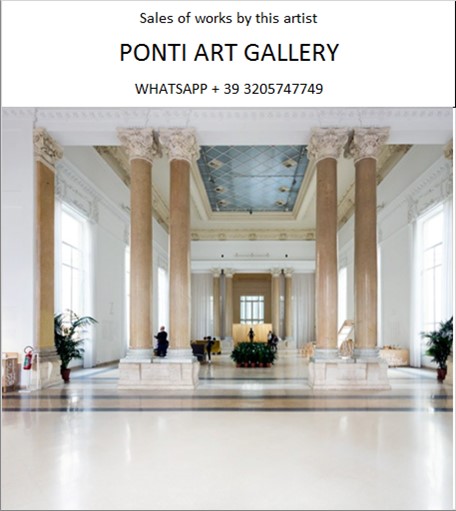Ponti Art Gallery is interested in buying and selling works
of art by this artist.

Lucio Fontana Biography
Lucio Fontana was an Argentine-Italian artist, widely recognized as one of the most innovative figures of post-war art. Born on February 19, 1899, in Rosario de Santa Fé, Argentina, Fontana was the son of Luigi Fontana, an Italian sculptor and architect, and Lucia Bottini, an Argentine actress. His early life was marked by a transatlantic existence, moving between Argentina and Italy, which would later influence his global perspective on art and culture.
Fontana's artistic journey began under the guidance of his father, from whom he learned the fundamentals of sculpture. In 1905, following his parents' separation, he moved to Italy, where he was exposed to the ideals of Futurism and new ways of creating art. During World War I, Fontana served as a second lieutenant in the Italian army, and after being wounded, he was discharged with a silver medal for military valor.
After the war, Fontana returned to Milan and resumed his studies, becoming a master builder, which laid the groundwork for his initial forays into sculpture. In 1922, he returned to Argentina, where he began working in his father's studio, specializing in sculptures for graveyards. His early works were characterized by a blend of traditional and innovative techniques, and by 1926, he was participating in exhibitions with the Nexus group of young Argentine artists.
Fontana's return to Milan in 1928 marked a significant turning point in his career. He enrolled at the Accademia di Belle Arti di Brera, studying under the Symbolist sculptor Adolfo Wildt. During this period, Fontana began to gain critical acclaim for his sculptures, which featured abstract human forms and unconventional materials, such as his work "Homo Nero" (1930), layered with tar.
The 1930s saw Fontana's involvement with the Parisian group Abstraction-Création and the Milanese anti-fascist artist group Corrente. He also collaborated with architects, further integrating his sculptural work into the broader context of spatial design. This period was marked by Fontana's exploration of abstract and expressionist styles, as well as his growing interest in the relationship between surface and space.
World War II prompted Fontana to return to Argentina, where he co-founded the experimental Altamira School of Arts in Buenos Aires. It was here that he co-authored the "Manifesto Blanco" (White Manifesto) in 1946, which laid the groundwork for his Spatialism movement. The manifesto called for a synthesis of color, sound, movement, and space, and advocated for the abandonment of traditional art forms in favor of new, spatially oriented art.
Upon his return to Milan in 1947, Fontana continued to develop the theories of Spatialism, producing a series of manifestos that emphasized the importance of space in art and the need to break free from the constraints of the two-dimensional canvas. His most iconic works, the "Concetti spaziali" (Spatial Concepts), began in the late 1940s. These works, characterized by punctures (buchi) and slashes (tagli) in monochrome canvases, sought to create a new dimension of depth and engage the viewer in a direct experience of spatial concepts.
Fontana's innovative approach extended beyond painting to encompass environmental installations, such as his "Ambiente spaziale a luce nera" (Spatial Environment in Black Light) created in 1949. These immersive works prefigured later developments in installation art and were influential in shaping the trajectory of post-war art.
Throughout his career, Fontana experimented with various materials and techniques, continually evolving his artistic language. His works often featured a combination of painting, sculpture, and performance, challenging traditional notions of art-making. Fontana's legacy is marked by his relentless pursuit of new forms of expression and his profound impact on the development of contemporary art.
Fontana's contributions to art were recognized during his lifetime, including being awarded the Grand Prize for painting at the Venice Biennale in 1966. He continued to work and exhibit internationally until his death on September 7, 1968, in Comabbio, Italy. Today, Fontana's works are held in the collections of major museums worldwide, and his influence continues to resonate in the art world.
Lucio Fontana Quotes and Sales
of Works
Ponti Art Gallery selects and deals with paintings by the
artist. Upon request, we provide free estimates and
evaluations, communicate prices, quotations, and current
market values.
If you are interested in BUYING or SELLING works by the
artist, contact us immediately.
If you wish to sell or receive an evaluation of the
works:
Send us a frontal photo of the painting, one of the back,
and one of the signature. Also, indicate the dimensions of
the work. Inform us about the purchase origin of the work
and any kind of available documentation (purchase
receipts, certificates of authenticity, publications). One
of our operators will respond to you on the same day. We
guarantee maximum confidentiality and extreme
professionalism.
If you wish to purchase works by the painter: Contact us
and let us know your request. We will inform you about the
available works. We also offer the possibility to
subscribe to our NEWSLETTER, through which you will be
informed at the beginning of each month about the latest
acquisitions of the art gallery.
You can send us pictures of the work:
